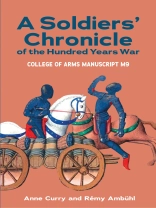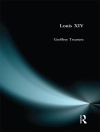A remarkable and very important unpublished chronicle written by two soldiers, covering in detail the English campaigns in France from 1415 to 1429. It lists many individuals who served in the war, and was written specifically for Sir John Fastolf, the English commander.
This previously unpublished chronicle from the mid-fifteenth century covers the English wars in France from 1415 to 1429. It is highly unusual in that it was written by two soldiers, Peter Basset and Christopher Hanson. William Worcester, secretary to the English commander Sir John Fastolf, also had a hand in it, and it was specifically written for Sir John. The content is unusual, as it includes many lists of individuals serving in the war, and records their presence at battles, naming more than 700 in all. Over half these individuals are French or Scottish, so it would seem that the authors had a particularly detailed knowledge of French military participation. The narrative is important for the English campaigns in Maine in the 1420s in which Fastolf was heavily involved and which otherwise receive little attention in chronicles written on either side of the Channel. The progress of the war is well mapped, with around 230 place names mentioned.
The chronicle was extensively used in the sixteenth century by several heralds and by Edward Hall. As a result, it had an influence on Shakespeare. The death of the earl of Salisbury at Orleans in ‘Henry VI Part I’ Follows the chronicle closely. The ‘Mirror for Magistrates’ Salisbury narrative is also derived from the chronicle. Another point of interest is that the chronicle is by a scribe who can be identified, and proves to be the only known fifteenth-century account of the war written in England in French, which adds an important linguistic dimension to its study.
表中的内容
List of Illustrations
Acknowledgements
Abbreviations
Introduction
Chapter 1. The M 9 chronicle and its authors
The chronicle manuscript and its scribe, Luket Nantron (Deborah Ellen Thorpe)
Peter Basset
Christopher Hanson
William Worcester
Team work
Chapter 2. The format and content of the M 9 chronicle
A work of two halves?
The English in the M 9 chronicle
The French in the M 9 chronicle
The lists
Chapter 3. The portrayal of war in the M 9 chronicle
The justification of war
Strategy and tactics
Battles
Sieges
Numbers and organisation
Bravery and cowardice
Oath taking and oath breaking
Conclusion
Chapter 4.
French in fifteenth-century England: what linguistic choices? (Richard Ingham)
Indications of non-native authorship?
Central French and other continental varieties
The French of England
Linguistic analysis of the M 9 chronicle
i. Orthography and grammar
ii. Lexis and phraseology
Conclusions
Chapter 5. The post-medieval history of the chronicle and its use by the heralds
The immediate fate of the chronicle
Heralds and the M 9 chronicle
a. Walter Bellengier
b. Christopher Barker
Other heralds and the annotations within the M 9 chronicle
The use of the chronicle by Robert Glover
Chapter 6.
The M 9 chronicle and the histories of the mid Tudor period
Edward Hall
Hall and the M 9 chronicle
Comparison of the M 9 chronicle and Hall’s
Union
The influence of Hall’s
Union
Shakespeare
The Basset problem
Chapter 7.
‘In the Mids of his Glory’: the M 9 chronicle, ‘A Mirror for Magistrates’, and the tragedy of English imperialism (Scott Lucas)
The Edition of College of Arms MS M 9 folios 31r-66r
Editorial practices
Edition of the original text and its annotations
English translation, identifications and commentary
Appendix: Additional material by William Worcester bound into College of Arms MS M 9
Bibliography
Index
关于作者
RÉMY AMBÜHL is Associate Professor in Medieval History at the University of Southampton, UK.












